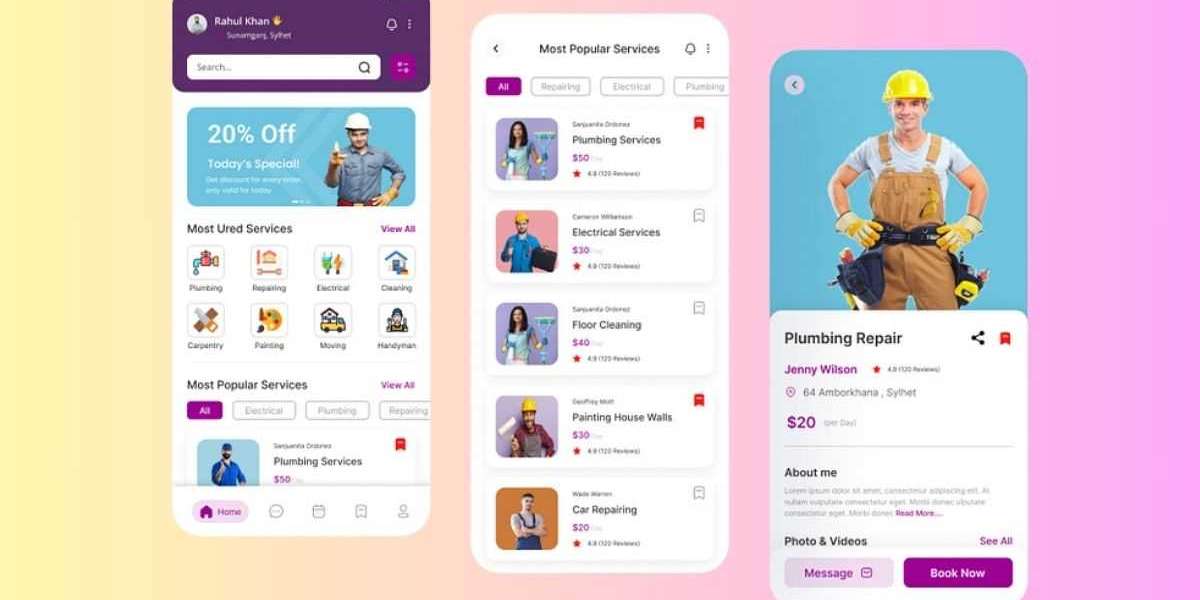Mobile applications have become an integral part of everyday life. They have also increasingly become invaluable tools for businesses across various industries to enhance operations and customer experience. The plumbing industry is no exception.
A plumber app developed specifically for plumbing businesses can help streamline several tasks and processes. It offers a platform for plumbers to manage appointments, invoices, inventory and communicate with customers efficiently. For customers, a plumbing app allows them to book appointments, pay bills, get service updates and even access a knowledge base for common plumbing queries all from their mobile devices.
The purpose of this blog is to provide a set of 12 key ideas that can help develop a useful and resourceful plumbing mobile app for businesses. An app with these features will aid both plumbers and customers with an improved experience at every step of service delivery.
Idea 1: Appointment Booking
One of the core functions of a plumbing app must be enabling customers to book appointments online easily. The app should allow customers to select services required, date, time and location preferences. It is advisable to provide flexible scheduling options including same day appointments.
On the plumber's end, the app can integrate calendars and schedules of available technicians. As appointments are booked, it automatically blocksOffTechnicianCalendars. This prevents double booking and helps manage appointments efficiently. The booking feature should also send automated confirmation emails/SMS to customers.
Idea 2: Service Requests
Along with appointments, the app must have an intuitive service request form that customers can use to report any plumbing issues. The form should collect key details like name, contact, property address, issue description with photos if possible.
These service requests are then assigned to relevant available plumbers based on their location, job type expertise through an automated dispatch system. Plumbers receive these requests on their devices to respond accordingly. Customers get timely updates on technician assignments through notifications.
Idea 3: Payment Processing
One major difficulty most businesses face is accepting and processing payments. The plumbing app must integrate robust payment gateways to allow customers to pay for services right from the app via various options like credit cards, net banking, digital wallets etc.
For users' security, sensitive financial data should not be stored. Payment pages must be PCI compliant as well. Post successful transactions, automated receipts can be generated and emailed. This digital payment processing removes the hassle of cash transactions for both customers and technicians on site.
Idea 4: Customer Dashboard
A personalized customer profile dashboard on the app enables users to keep a track of their orders, payments, coupon codes and loyalty points earned over time. Customers must be able to pull appointment details, invoices and view payment statuses from past orders.
The dashboard should also surface any ongoing or upcoming scheduled appointments on calendars. Users get proactive updates on service status changes through push notifications from dispatched technicians. Overall, the dashboard builds transparency by keeping customers in the loop throughout service engagements. Read more: https://zipprr.com/uber-for-plumbers/
Idea 5: Plumber Profiles
Similarly, the app needs to have detailed profiles for each associated plumber. These profiles acts as their virtual business cards allowing potential customers to learn more about technicians. Key details that must be included are:
- Qualifications, Experience, Specializations
- Service areas and available time slots
- Profile photo
- Previous work portfolio/case studies
- Verified licenses and certifications
- Reviews and ratings from past customers
Well-maintained profiles help customers evaluate plumbers based on their needs and choose reliable service providers. It also boosts plumbers credibility and visibility leading to more work opportunities.
Idea 6: Real-Time Tracking
Transparency during service visits is an area the app needs to excell in. It can empower real-time location sharing between customers and technicians using GPS. As a plumber is dispatched, his ETA and live location details must be viewable to the customer.
Likewise, customers location will also be visible to the plumber until he reaches the destination. Both parties stay updated on each other's movements. The feature enhances accountability by imposing location sharing between supplier and end-user. With transparency, relationships build trust among stakeholders involved.
Idea 7: Inventory Management
Keeping track of inventory is another critical task for service technicians. The plumbing app allows them to create digital inventories of tools, equipment and spare parts carried in their vans.
Items can be categorized, barcode scanned for easy identification and quantities updated. When stock goes below predefined thresholds, automatic purchase/reorder alerts notify technicians. This digital log prevents stockouts and helps run operations seamlessly. Reports can also analyze most frequently used items.
Idea 8: Invoicing
Once the job is completed, digital invoices neeed to be generated swiftly for the customer's records. Invoices created from the plumbing app must contain:
- Customer and technician details
- Service address, date
- Itemized list of parts and services provided
- Applicable taxes
- Total amount due
- Payment terms
Invoices sent via email acts as receipts and can be useful for tax/warranty purposes. It eliminates paper-based invoicing and gets transactions digitally documented. Customers have on-demand access to past invoices anytime from their profile dashboards.
Idea 9: Push Notifications
Proactive communication keeps all stakeholders regularly updated on changes. Leveraging push notifications, the plumbing app can send automated messages for:
- Appointment/request booking confirmations
- Scheduled appointment reminders
- Technician dispatch status updates
- Invoice generation alerts
- Service completion notifications
- Critical alerts like delays, rescheduling etc.
Notifications serve as status beacons improving response times and eliminating waiting periods for information. Users stay engaged while on-the-go even without opening the app frequently. It strengthens customer relationships and satisfaction levels.
Idea 10: Reviews and Ratings
Valuable reviews and ratings are excellent credibility markers for any local business. The plumbing app mandates capturing honest customer feedback for each technician's performance on a 5-star scale.
Negative and positive reviews with experiences are published anonymously post service. Plumbers too can reply to reviews professionally for better transparency. Aggregate numbers determine overall plumber star ratings helping customers make informed choices. Simultaneously, ratings act as quality monitors motivating better service standards.
Idea 11: Knowledge Base
Customers should be able to self-diagnose and address minor issues without scheduling full-fledged appointments always. The app's knowledge base must compile a growing library of frequently asked plumbing questions.
Common troubleshooting topics could be related to leak detection, drainage cleaning, water heater maintenance and more. Step-by-step DIY solutions empower do-it-yourself tasks. Users can even post new questions for plumbers to answer building an engaged community. This educates customers and reduces unnecessary job requests in the long run.
Idea 12: Analytics and Reports
Business owners require key performance data and insights into operations. The plumbing app maintains a simple dashboard providing summarized analytics, visual reports and vital metrics like:
- Monthly revenue stats and trend analysis
- Top performing technicians
- Busiest days of week/months
- Most frequently requested services
- Customer retention and churn rates
- Average response/completion times
- Inventory stock levels
- Payment modes and failure ratios
With visibility into numbers, owners can optimize processes. Reports spot operational gaps proactively and benchmark performance against industry standards on a periodic basis. Data-backed decisions aid profits, productivity and enhance customer satisfaction over time.
Conclusion
A well-designed plumbing mobile application with the above ideas has immense potential to digitally transform service experiences. It streamlines processes across scheduling, dispatch, payments, inventory and communication among stakeholders. Simultaneously, the app addresses relevant pain points of both customers and businesses through convenient features.
Adopting the right ideas ensures creating an all-encompassing platform catering to users' evolving needs. While the initial development requires investments, the long term advantages of customer retention, brand visibility and optimized operations outweigh costs. Plumbers can reach more customers, focus on fieldwork and gain operational control remotely via a successful app.
Customers enjoy transparency with real-time interactions, self-service options and an overall hassle-free experience of issue reporting, tracking and billing. Lastly, actionable analytics further helps owners and technicians identify growth opportunities continuously improving the business. A plumbing app powered by the suggestions can essentially transform service experiences digitally for the new era.







